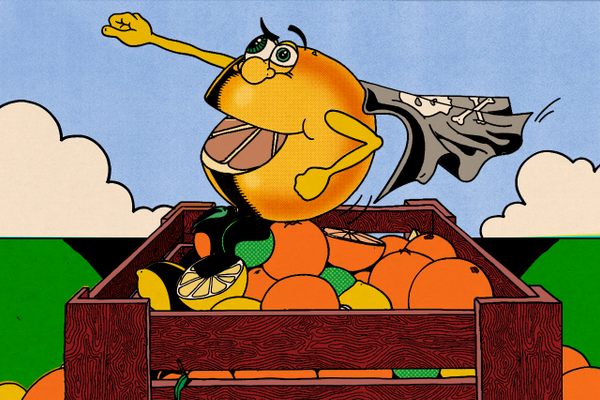Can Nigerian Drumming Teach You to Pick the Perfect Watermelon?
Acoustics is here to help you find ripe produce.

For Ogbodo Nkiruka, the slap of a hand hitting a watermelon is a welcome melody. A fruit vendor who’s been selling watermelons from a roadside stand in the Nigerian city of Enugu for 15 years, she identifies the ripeness of her wares by ear. Each melon has its own music, a deep, hollow thump—ba ba, ba, ba— indicating a fruit that’s perfectly ripe.
When Stephen Gbakobachukwu Onwubiko, an independent acoustics researcher based in Nigeria, first stumbled across Nkiruka’s stand, the thwack of hand on watermelon struck him like a drum—literally. “Those pitches can be correlated with the Nigerian drum,” Onwubiko says. The sounds were so similar, in fact, he wondered whether Nigerian fruit sellers might be uniquely equipped to detect watermelon ripeness due to their familiarity with traditional drumming.
Onwubiko is specifically referring to the igba, a cylindrical drum played across Nigeria and particularly among Igbo people. Igbas are played at occasions ranging from festivals to funerals, and they come in many varieties. “There’s the male drum, the female drum,” says Onwubiko. “There are drums played for spirits, there are drums played for kings.” But the drums share a special attribute: They “talk.”

Skilled players can make the drum beats mimic the tones of spoken words, and before telecommunication, drum patterns were used to send messages across long distances. Today, many urban Nigerians, who didn’t grow up using drums this way, may not have as developed an ability to interpret the rhythms as their rural counterparts, says Onwubiko. Still, igba drumming remains a ubiquitous cultural form. So Onwubiko wondered: Could familiarity with igba drumming train fruit sellers’ ears to more easily detect the sound of a ripe watermelon?

To test the hypothesis, Onwubiko conducted a study with collaborators Traci Neilsen, associate professor of physics at Brigham Young University, and Andrea Calilhanna, a music researcher from the University of Sydney in Australia. Onwubiko interviewed fruit sellers in Nigeria, then recorded both the sound of an igba drum and the slap of a ripe watermelon. Neilsen translated that audio into a spectrogram, a visualization of the frequencies of the sound waves over time. By comparing the spectrograms of the ripe watermelon and the igba drum, the researchers found that the two sounds had a similar duration and initial frequencies, giving them a similar timbre or tone quality. The researchers theorize that the similarity between the drum sound and the watermelon slap may prime fruit sellers to more easily detect watermelon ripeness. “They have subconsciously or subliminally received ear training that makes it easier,” Neilsen says.
Of course, Nkiruka, the Enugu watermelon seller, didn’t have to conduct a formal acoustical study to understand the similarity between Igba drumming and the hollow echo of a ripe watermelon. Instead, watermelon vendors’ knowledge is a form of “internalized, embodied acoustics,” Onwubiko says. This more subtle influence of sound on everything from our mood to our decision-making falls under the field of psychoacoustics, Onwubiko’s research specialty.
The technical definition of psychoacoustics labels it the study of the interplay between the physics of sound—the movement of sound waves through space—and its psychology, or how we perceive and understand it. For Onwubiko, however, the best definition of psychoacoustics is visceral. “There is a drum slapping that will give me goosebumps,” he says, whereas it may not affect a listener unaccustomed to Nigerian music. This difference in reactions is the domain of psychoacoustics, and it’s this deeper, more subliminal relationship between culture, psychology, and sound that may make Nigerian fruit sellers experts at detecting ripe watermelons.

Neilsen, who presented the preliminary findings at a recent meeting of the Acoustical Society of America, says the group needs to conduct more research before they can precisely quantify the perfect ripe watermelon sound. Even at a preliminary stage, however, the group’s research suggests one answer to the age-old question facing anyone who taps on a watermelon at a supermarket or roadside stand.
“Everybody’s thumped a watermelon and wondered what they’re supposed to be listening for,” says Neilsen. It turns out we’ve been listening for the sweet beat of an igba drum all along.
Gastro Obscura covers the world’s most wondrous food and drink.
Sign up for our regular newsletter.





































Follow us on Twitter to get the latest on the world's hidden wonders.
Like us on Facebook to get the latest on the world's hidden wonders.
Follow us on Twitter Like us on Facebook